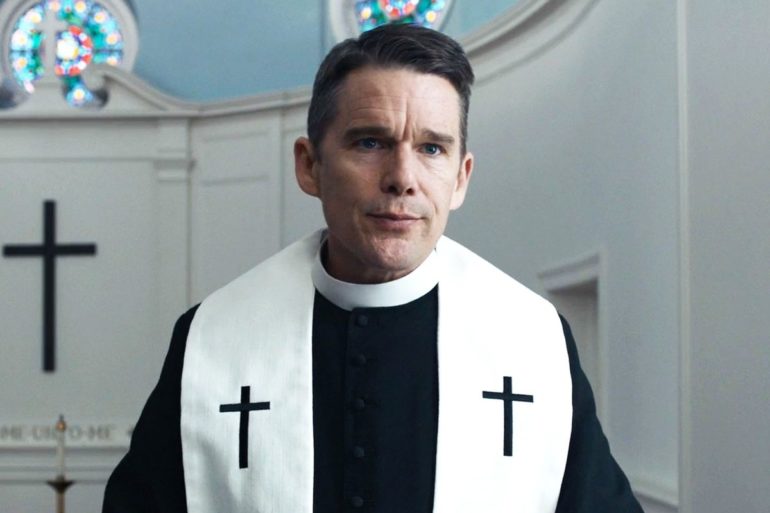Every Easter, I tackle a film or book that deals with themes of the season, or has a setting that occurs around that time of the year. There was Scorsese’s Silence in 2019, Chocolat in 2020, Steel Magnolias in 2021, Signs in 2022 and Knock in the Cabin in 2023. This year, I turn my attention to Paul Schrader’s wonderfully textured film First Reformed.
Ethan Hawke plays Reverend Toller, a man of the cloth who is unable to pray. He had urged his son to enlist in the Iraq War, and 6 months later, his son was dead, for a war effort that was essentially meaningless. His wife left him soon after.
A member of the parish, Mary (Amanda Seyfried), requests that he counsel her husband Michael (Philip Ettinger). Michael is part of the green movement and against bringing their unborn baby into the world because of how unlivable the earth will be in his child’s lifetime. How can you justify bringing a child into a world you know is doomed? Toller knows his task, and that is to urge this young man back from the darkness of despair, to encourage him to hope. But we can see on Toller’s face that he doesn’t believe in what he’s saying, preaching faithlessly about keeping God’s purpose in mind in order to save a young man who has already made a irrevocable decision.
Toller spends quite a bit of his time running the souvenir shop tied to First Reformed, reduced to a mere tour guide encouraging visitors to buy merch, an endeavour he finds painfully intolerable. Nearly everything is handled by the church Abundant Life, with First Reformed relegated to the sidelines, much like how Toller is.
The imagery that inundates the film is drab, bleak, imposing, with very little movement and dynamism. This gives us insight into Toller’s world as a lonely, austere man who’s just existing, much like a drifting piece of debris in the wide ocean. His physical health is in the same state as his spiritual health, and it’s clear that the problem is quite extensive considering the amount of blood in his urine.
First Reformed is about the two pillars that govern our existence: hope and despair. We all have worries, doubts, obstacles in our lives, but if our scales lean towards despair more than hope, then these aspects become insurmountable, and life as a result is just too much to bear. This is where Mary and Michael differ: she wants to live despite her worries about her child’s future, but he is overcome with thoughts of doom and anguish. It is because of this that he takes his own life. It is Toller who stumbles upon this crimson sight, once again drowning in the loss of being unable to save yet another young man.
So much of the film’s cinematography is static, that when there’s something moving, we pay attention. We see this when Toller and Mary ride bicycles through the park, and we’re made privy to a greyish, blue sky littered with barren trees. We see him smile a genuine smile of enjoyment, and he even attributes his enjoyment as something God has bestowed upon us – the joys of exercise. Michael’s death stirs something within him, as we see him gaining interest in the green movement, and he no longer stays silent so as to avoid conflict. Even in his moment of connection with Mary, he can’t stop thinking about the environmental catastrophe that approaches. He is so eager to find a sense of meaning in his life that he turns to extremism to fulfil that, but all it does is contribute to his existing disillusionment.
Toller decides that death through a suicide vest is the way to go, and dons it before going out to face the congregation on First Reformed’s 250th anniversary. However, when he sees Mary enter the church, he changes his mind, moving to his chambers to remove the vest and takes a barbed wire to his body instead. The final touch is the liquid drano that he pours into his glass, which he holds up to his lips to drink.
But then Mary shows up. He goes to embrace her, and they share a passionate, moving kiss, a rotating camera shot infusing these ending moments with a pulsing sense of life. There’s a certain fixation with whether Toller is alive – seeing Mary stops him from killing himself – or he’s dead and in these last moments he is given a glimpse of heaven. However, whether he’s alive or dead isn’t really the point. For the entire film, Toller despairs that he is unable to pray anymore. He feels distant from God, and we see him grasping at what God’s intention could be through his various conversations, but ultimately still in the dark. The conclusion of the film represents his salvation, because at the end what he holds within him is not despair, but the beauty of love and connection.
READ NEXT: 10 Underrated Movies of 2023 You Should Watch
Some of the coverage you find on Cultured Vultures contains affiliate links, which provide us with small commissions based on purchases made from visiting our site.

